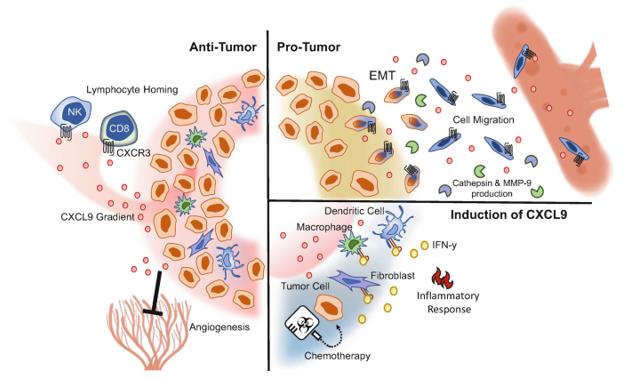What is CXCL9 Protein
CXCL9, officially known as C-X-C motif chemokine ligand 9, is a member of the chemokine family, a group of small cytokines responsible for guiding immune cells to their respective targets. This vital protein is also recognized by other aliases, including Monokine induced by gamma interferon (MIG) and Small inducible cytokine subfamily B, member 9 (SCYB9). Structurally, CXCL9 boasts a characteristic four-stranded β-sheet and two alpha-helices, classified as a CXC chemokine due to its N-terminal cysteine residues. Recent research has shed light on its significant role in immune responses, highlighting its potential as a therapeutic target.
CXCL9 Biological Functions and Molecular Mechanisms
The biological functions of CXCL9 are intricately woven into the fabric of the immune system. Primarily induced by gamma interferon, CXCL9 plays a pivotal role in orchestrating the migration of immune cells, particularly T lymphocytes and natural killer (NK) cells. Its molecular mechanisms involve binding to the CXCR3 receptor, triggering a cascade of events that result in chemotaxis. This chemotactic activity is crucial for the recruitment of immune cells to sites of infection or inflammation.
Beyond its chemotactic prowess, CXCL9 is recognized for its immunomodulatory effects. It participates in the regulation of immune responses, influencing the balance between pro-inflammatory and anti-inflammatory signals. The intricate dance between CXCL9 and its receptor CXCR3 modulates the immune microenvironment, contributing to the body's ability to combat infections and maintain homeostasis.

Figure 1. The multifaceted roles of CXCL9 within the tumor microenvironment. (Neo S Y, et al., 2020)
CXCL9 Related Signaling Pathway
The CXCL9 signal pathway is intricately connected to the CXCR3 receptor. Upon binding, CXCL9 activates a signaling cascade that involves various intracellular pathways, including the JAK-STAT pathway. This activation triggers the expression of genes associated with immune responses, further amplifying the body's defense mechanisms. The tight regulation of this pathway is essential for maintaining immune homeostasis, and dysregulation can lead to immune-related disorders.
CXCL9 Related Diseases
The dysregulation of CXCL9 has been implicated in various diseases, shedding light on its clinical significance. In the context of inflammatory disorders, aberrant CXCL9 expression is associated with conditions such as rheumatoid arthritis and inflammatory bowel diseases. Moreover, in the realm of infectious diseases, CXCL9's role in shaping the immune response has been explored in the context of viral infections, including HIV and hepatitis C.
In cancer, CXCL9 takes on a dual role. On one hand, its presence is associated with a favorable prognosis in certain cancers, indicating a robust anti-tumor immune response. On the other hand, it can contribute to the establishment of an immunosuppressive tumor microenvironment in other cases. This duality underscores the complexity of CXCL9's involvement in cancer and highlights its potential as a therapeutic target for immunotherapy.
CXCL9's Applications in Biomedicine
The multifaceted roles of CXCL9 have paved the way for its applications in biomedical research and development. In diagnostics, CXCL9 is emerging as a potential biomarker for various inflammatory conditions. Its expression profiles in different diseases make it a promising candidate for the development of diagnostic tools, enabling early and accurate disease detection.
In vaccine development, CXCL9's ability to orchestrate immune cell migration presents an opportunity to enhance vaccine efficacy. Strategies involving the manipulation of CXCL9 expression could be explored to improve the recruitment of immune cells to vaccination sites, thereby bolstering the immune response.
On the therapeutic front, targeting CXCL9 holds promise for modulating immune responses in various diseases. Research is underway to develop drugs that selectively modulate CXCL9 activity, providing a targeted approach for conditions where its dysregulation plays a pathological role.
Recommended Products
| Cat.No. | Product Name | Species | Source (Host) | Tag |
|---|---|---|---|---|
| CXCL9-11728H | Recombinant Human CXCL9, His-tagged | Human | E.coli | His |
| CXCL9-553H | Recombinant Human CXCL9 | Human | Mammalian Cell | His |
| CXCL9-210H | Recombinant Human chemokine (C-X-C motif) ligand 9, His-tagged | Human | E.coli | His |
| CXCL9-631H | Recombinant Human CXCL9, None tagged | Human | E.coli | N/A |
| Cxcl9-201M | Recombinant Mouse Cxcl9 protein | Mouse | E.coli | N/A |
| CXCL9-4352R | Recombinant Rabbit CXCL9 Protein | Rabbit | Yeast | N/A |
| CXCL9-4395C | Recombinant Cynomolgus Monkey CXCL9 Protein | Cynomolgus Monkey | Yeast | N/A |
| CXCL9-1112R | Recombinant Rhesus monkey CXCL9 Protein, His-tagged | Rhesus Macaque | Mammalian Cell | His |
| CXCL9-937R | Recombinant Rhesus Macaque CXCL9 Protein, His (Fc)-Avi-tagged | Rhesus Macaque | HEK293 | His (Fc)-Avi |
| CXCL9-02P | Recombinant Pig CXCL9 Protein (Thr23-Thr126), N-His tagged, Animal-free, Carrier-free | Pig | E.coli | N-His |
Reference
- Neo S Y, Lundqvist A. The multifaceted roles of CXCL9 within the tumor microenvironment. Tumor Microenvironment: The Role of Chemokines–Part A, 2020: 45-51.

